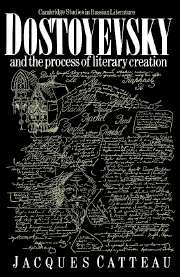Book contents
- Frontmatter
- Contents
- Preface to the English edition
- List of abbreviations
- General editor's note on transliteration and references
- General introduction
- PART I The creative environment
- PART II The process of creation
- Introduction
- 7 The writer at work
- 8 The great dialogue: the news item
- 9 The great dialogue: migrant images
- 10 The play of dialogue
- 11 The unity of thought in the novel
- 12 The summit of creative interrogation: ‘The Life of a Great Sinner’
- 13 A Raw Youth: reasons for choice
- 14 A Raw Youth: the appearance of the vision
- 15 A Raw Youth: the human architecture
- 16 A Raw Youth: the Idea of the novel
- 17 The composition of the novel in Dostoyevsky's work: choice of chronicle form
- 18 Composition of the novel in A Raw Youth: chronicle and stories
- Part III Time and space in the world of the novels
- Conclusion
- Notes
- Select bibliography
- Index of names
11 - The unity of thought in the novel
Published online by Cambridge University Press: 18 December 2009
- Frontmatter
- Contents
- Preface to the English edition
- List of abbreviations
- General editor's note on transliteration and references
- General introduction
- PART I The creative environment
- PART II The process of creation
- Introduction
- 7 The writer at work
- 8 The great dialogue: the news item
- 9 The great dialogue: migrant images
- 10 The play of dialogue
- 11 The unity of thought in the novel
- 12 The summit of creative interrogation: ‘The Life of a Great Sinner’
- 13 A Raw Youth: reasons for choice
- 14 A Raw Youth: the appearance of the vision
- 15 A Raw Youth: the human architecture
- 16 A Raw Youth: the Idea of the novel
- 17 The composition of the novel in Dostoyevsky's work: choice of chronicle form
- 18 Composition of the novel in A Raw Youth: chronicle and stories
- Part III Time and space in the world of the novels
- Conclusion
- Notes
- Select bibliography
- Index of names
Summary
Trying to understand the structure of The Divine Comedy, I came to the conclusion that the whole poem is a single united and unbreakable strophe. Or, more exactly, it is not a verse strophe, but a crystallographic figure, a solid.
Osip Mandelstam, Conversation about DanteA genius, in Dostoyevsky's eyes, is someone who brings a ‘new word’ (novoe slovo). The new word is a message, though it may be in the shape of a question, as well as a new vision of the world and the creation of a universe. The best illustration appears in the famous lecture on Pushkin, 8 June 1880. Dostoyevsky took the poet's work as a whole in all its protean shapes, a whole whose meaning seemed so clear to him that he condensed it into four basic points in the ‘word of explanation’ which acted as preface for the publication of the lecture in the only issue of Diary of a Writer for 1880. We are concerned only with his approach, which was the same as that he adopted towards Cervantes, George Sand and Nekrasov. For Dostoyevsky, every great writer gave birth to a total work, whose vector, perfectly drawn at the moment of death, was constantly present at each stage of his evolution. Dostoyevsky always analysed with a view to synthesis. We may go on to consider his attitude towards his own work. Was he creating a unity? Was he, like Dante in The Divine Comedy, Balzac in The Human Comedy and Proust in Recollections of Time Past, pursuing a great continuous design throughout his work? Would he have wished to do so, even if it had been possible?
- Type
- Chapter
- Information
- Dostoyevsky and the Process of Literary Creation , pp. 216 - 223Publisher: Cambridge University PressPrint publication year: 1989



